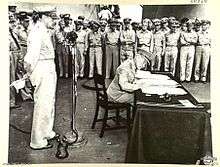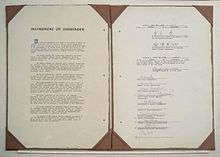Lawrence Moore Cosgrave
Colonel Lawrence Vincent Moore Cosgrave, DSO & Bar (August 28, 1890 – July 28, 1971) was a Canadian soldier and diplomat. He was the Canadian signatory to the Japanese Instrument of Surrender at the end of World War II.
Lawrence Moore Cosgrave | |
|---|---|
 Cosgrave signing the Japanese Instrument of Surrender aboard the battleship USS Missouri in Tokyo Bay on September 2, 1945. | |
| Born | August 28, 1890 Toronto, Ontario, Canada |
| Died | July 28, 1971 (aged 80) Knowlton, Quebec, Canada |
| Allegiance | Canada |
| Service/ | Canadian Army |
| Rank | Colonel |
| Awards | Distinguished Service Order & Bar Croix de Guerre (France) |
| Other work | Diplomat |
Early life
Cosgrave was born in Toronto, Ontario, on August 28, 1890. Cosgrave was the son of Lawrence J., founder of Cosgrave & Sons Brewery Company, and brother of James, a partner with E. P. Taylor in horse racing's Cosgrave Stables. Lawrence was a 1912 graduate of the Royal Military College of Canada, student # 851[1] and subsequently attended McGill University.
Military service
In World War I he served as a junior artillery officer in the Canadian Field Artillery in France. Cosgrave was awarded the Distinguished Service Order first in 1916 and again in 1918; later Cosgrave was presented with the French Croix de Guerre.
Services to Canada
Cosgrave served as the Assistant Canadian Government Trade Commissioner in London from 1922 to 1924; Canadian Trade Commissioner at the British Empire Exhibition at Wembley Park in 1924; at Shanghai from 1925 to 1935; at Melbourne from 1935 to 1937; and at Sydney from 1937 to 1942.

During World War II Cosgrave was the Canadian Military Attache to Australia, for the South West Pacific Area. On September 2, 1945 he was the Canadian representative at the official surrender of Japan, and signed the Japanese Instrument of Surrender on behalf of Canada aboard the battleship USS Missouri in Tokyo Bay. When his turn to sign came, Cosgrave inadvertently placed his signature one line too low on the Japanese copy of the documents, signing on the line for the French Republic. This was attributed to his being blind in one eye, through an injury sustained in the First World War. Each succeeding representative then signed on the line below their assigned line on that copy of the documents.
Air Vice-Marshal Leonard Monk Isitt, the Dominion of New Zealand representative, left without a blank to sign, had to have his name and country written in at the bottom margin of the document. Cosgrave did not repeat this error on the American copy. The error was "corrected" by US General Richard Sutherland who crossed out "French Republic" and wrote in "Dominion of Canada" under Cosgrave's signature, then made similar corrections for the rest of the document.[2]
Cosgrave knew Mamoru Shigemitsu, who signed the instrument of surrender on behalf of the Japanese Emperor and Government, from their diplomatic days in Shanghai. It is reported that their eyes met when Mamoru Shigemitsu boarded the Missouri, they both smiled with mutual recognition, before Shigemitsu once more became stern and serious. They met each other again a number of years later in London at the Coronation of Elizabeth II in 1953.[3]
Cosgrave stated that his friend Lieutenant Colonel John McCrae wrote the poem "In Flanders Fields" on a scrap of paper resting on Cosgrave's back during a lull in the bombings on May 3, 1915, the day after McCrae had witnessed the death of his friend, Lieutenant Alexis Helmer. The poem was first published on December 8 that year in the London-based magazine Punch. Cosgrave unveiled the Colonel John McCrae Memorial, at Boezinge, Ypres, West Flanders, on October 5, 1963.
Cosgrave wrote "Afterthoughts of Armageddon, the gamut of emotions produced by the war, pointing to a moral that is not too obvious", published 1919 by his wife Beryl (née Hunter Jones), Toronto.[4]
After the war
Cosgrave's service to Canada continued after the war in various consular posts in Asia; and in the 1950s, his diplomatic career continued in European consular posts.[2] For instance, he was Chargé d'Affaires in Portugal from 1952 through 1955.[5]
On July 28, 1971, Cosgrave died at his home in Knowlton (Eastern Townships), province of Quebec .
Notes
- RMC post-nominals are student numbers and/or Military Colleges Alumni club numbers. The numbers are sequential and meaningful to alumni. Honorary graduates start with an H. The earlier alumni were ranked by their examination scores and (only) top candidates would be offered a commission.
- Ellwand, Geoff. "Making a mess of history," CBC News. April 27, 2006.
- (recited by Col. Lawrence Moore Cosgrave DSO, to his Grandson).
- Archive.org Afterthoughts of Armageddon, retrieved 2012-03-25
- Foreign Affairs and International Trade Canada Complete List of Posts
References
- Preston, Adrian (RMC 4237). and Peter Dennis. (1976). Swords and Covenants. London: Croom Helm; Lanham, Maryland: Rowman and Littlefield. ISBN 978-0-87471-862-1
- Preston, Richard Arthur (RMC H16511). (1991). To Serve Canada: A History of the Royal Military College of Canada. Ottawa: University of Ottawa Press. ISBN 978-0-7766-0327-8 (cloth)
- ____________. (1970). Canada's RMC -- A History of Royal Military College, 2nd edition, 1982. Toronto: University of Toronto Press. ISBN 978-0-8020-3222-5 (cloth)
- ____________. (1968). R.M.C. and Kingston: The Effect of Imperial and Military Influences on a Canadian Community. Raleigh, North Carolina: Duke University Press; see Ontario History. Vol. 60, pp. 105–123. September 1968. Kingston, Ontario.
- Smith, R. Guy C. (RMC H1877). (1984). As You Were! Ex-Cadets Remember, Vol. I, 1876–1918; Volume II, 1919-1984. Kingston, Ontario: RMC. The R.M.C. Club of Canada.
| Wikimedia Commons has media related to Lawrence Moore Cosgrave. |